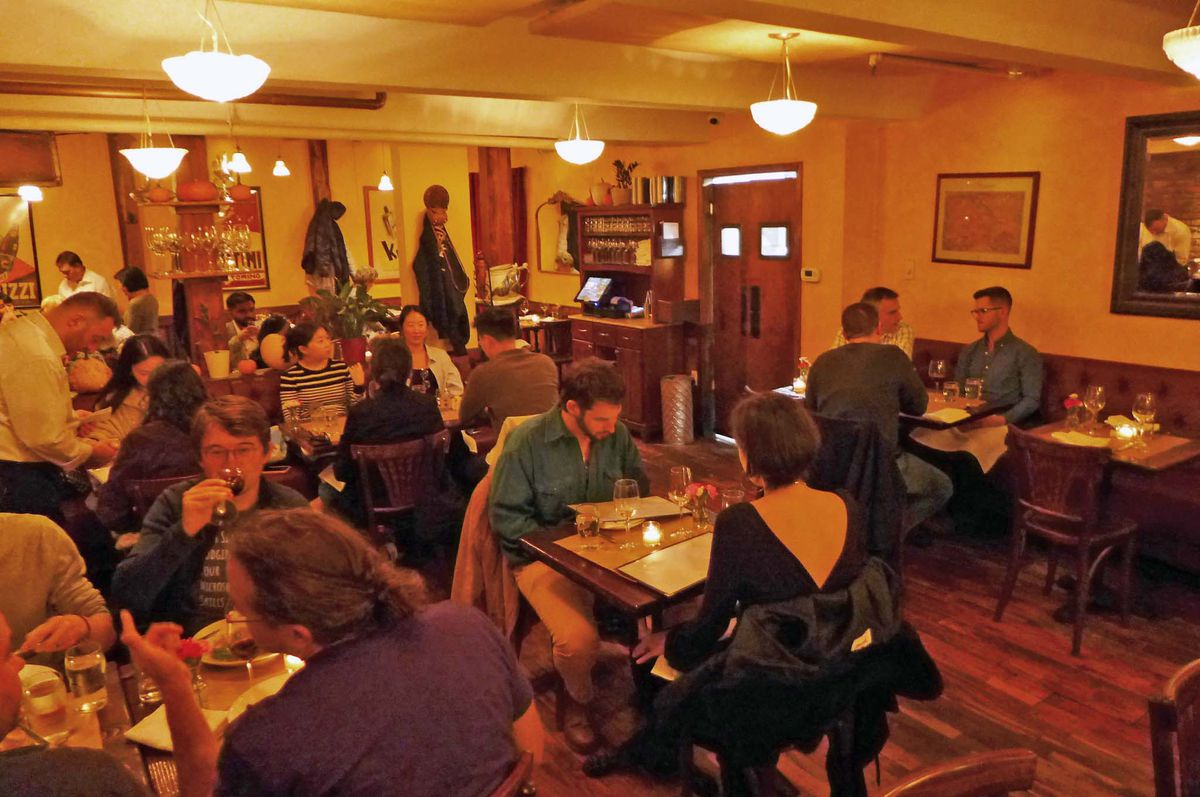When Da Andrea (“from Andrea”) opened in the early ’90s on Hudson Street, it served Bolognese pastas in a narrow storefront, with low prices that attracted neighborhood devotees: The West Village was not quite so wealthy then, or the sort of restaurant destination it has become today. By 2002, Da Andrea had garnered enough attention that Sam Sifton gave it a rave review in the New York Times. Dial forward nearly two decades, and with changes of ownership, it moved to 35 West 13th Street between Fifth and Sixth avenues, amidst the New School, where it remains today.

From across the street, the premises glow like a city in the desert at night. Strings of tiny lights illuminate outdoor sheds, sprouting forests of foliage both real and fake. Inside the restaurant, a greeter stands behind a podium in front of the doorway, and the bar and double dining rooms are up a few steps. The walls are covered with art, while the tables are spaced closely together, seating an estimated 80 or so. The place is filled by 7 p.m., even on a Monday night, and the waiters must contort themselves to get to remote tables.
The food lagged when the new location opened in 2009, but since then has improved tremendously, so that two friends and I had a near-perfect meal on a recent revisit. We ordered mainly Sicilian dishes and asked that the meal be sent out in three courses — apps, pastas, and a single shared main course — and the staff readily complied. (Often despite my request, the second and third courses appear at the same time.)
First to hit the table was a warm octopus salad ($19) heaped with potatoes, Gaeta olives, and sauteed peppers added a sweet kick. The octopus had been perfectly poached and then grilled so that it wasn’t too hard and wasn’t too soft; on a brisk fall evening, the warmth of the salad was welcome. Soon after a Caesar salad arrived wearing a pair of anchovies bravely on its breast like a war hero. The dressing was loaded with Parmesan and more anchovies, so if you are the kind of person who loves strongly flavored salads, this is for you.

Two pastas were easily enough for three to share. Pennette con melanzane ($25) is the restaurant’s twist on Sicily’s signature pasta, pasta alla Norma — named after an opera by Bellini. Bouncy, sticky, and red-sauced, the tubular pasta featured eggplant and mozzarella, and proved perfectly fine, especially with Romano sprinkled liberally over the top. What really blew us away were some half-moon ravioli stuffed with the ungainly combination of veal and spinach. Called ravioli di vitello ($26), it rested in a thick cream sauce dotted with mushrooms and ham. This was one of the best pastas I’ve had all year.
Zuppa di pesce at Da Andrea.
Beware: It was so rich we weren’t quite ready as the third course was carried in, a lovely Sicilian seafood stew (zuppa di pesce, $36) loaded with mussels, fin fish, shrimp, and a bay scallop or two in a bright orange broth. It was Sicily’s answer to bouillabaisse, and the bowl was so generous, we couldn’t quite finish it.

Even so, we proceeded to the dessert course ($11 each), which held no surprises but was a fitting conclusion to a great New York-style Italian meal. The ricotta cheesecake and panna cotta — which looked similar — were both more than adequate, though I liked the former for its deep red Amarena cherries.
If the restaurant has a flaw, it’s that many aspects of Da Andrea now seem corporate, from the fading art to the regimented organization of the service staff to the wine list. The latter was a tad too well-thought-out, as if sourced in a very deep corporate cellar, with a limited by-the-glass list aimed at the run-of-the-mill customer, and a collection of higher-priced bottles, many a good value, aimed at high rollers.
One that attracted my attention was an Umbrian bottle of eight-year-old Sagrantino di Montefalco from Colpetrone ($81), a wine that bests Brunello from neighboring Tuscany as far as I’m concerned, with a similar grape and the perfect amount of age. We didn’t order it because we weren’t eating the heavy red meats that would go with it.
Instead, we went with by-the-glass choices, including a couple of Sicilian whites: grillo ($14), a hearty straw-yellow wine that can stand up to red-sauced pastas. Subtler, lighter, and drier was an Etna Bianco ($19) that tasted of its volcanic soil. We left the restaurant pleased with our meal, but missing the original Da Andrea, too.
